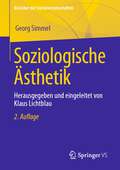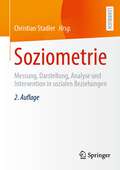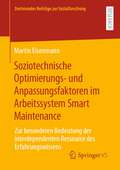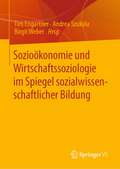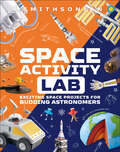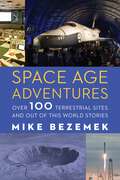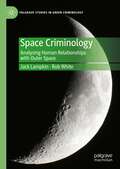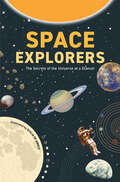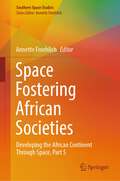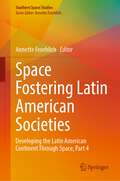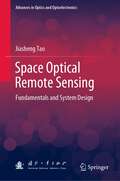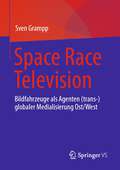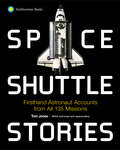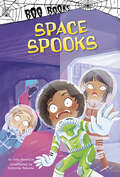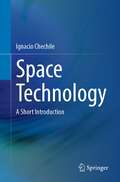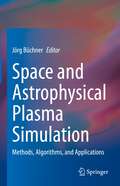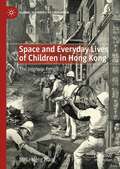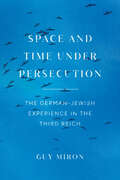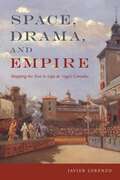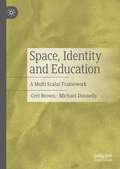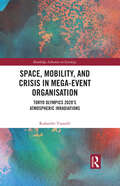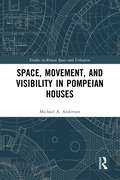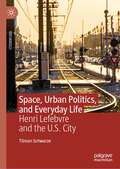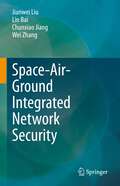- Table View
- List View
Soziologische Ästhetik: Herausgegeben und eingeleitet von Klaus Lichtblau (Klassiker der Sozialwissenschaften)
by Georg SimmelGeorg Simmel gilt zu Recht als ein klassischer Theoretiker der Moderne. Er sah im Überschneidungsbereich von ästhetischer Erfahrung und einer genuin soziologischen Beschreibung von Modernität die Möglichkeit gegeben, der epochalen Eigenart des modernen Lebens mit all seinen Spannungen, Konflikten und Paradoxien auf die Spur zu kommen, ohne diese vorschnell unter eine begriffliche Systematik zu subsumieren. In diesem Band wird Simmels Programm einer „soziologischen Ästhetik“ unter anderem anhand einiger seiner kunstkritischen Schriften aus den 1890er Jahren, seiner Arbeiten über die Rolle der modernen Kunst- und Gewerbeausstellungen, der Mode und dem Schmuck sowie seiner luziden Studien über die Geselligkeit und die Koketterie dokumentiert.
Soziometrie: Messung, Darstellung, Analyse und Intervention in sozialen Beziehungen
by Christian StadlerSoziometrie ist eine sowohl qualitative wie quantitative Herangehensweise, um Beziehungen in Gruppen zu untersuchen. Sie untersucht das Wahlverhalten von Menschen anhand bestimmter Kriterien und dient gleichzeitig als Intervention für eine Verbesserung von Gruppenzusammenhalt und -leistung. Dieses Buch bietet eine kompakte Einführung in die Grundlagen der Soziometrie. Es werden unter anderem das sozionomischen System, verwandte Untersuchungsmethoden und Weiterentwicklungen (z.B. der populären Netzwerkananalyse) sowie zahlreiche Instrumente und psychodramatische Messverfahren dargestellt. Darüber hinaus werden in einem Praxisteil zahlreiche Fallbeispiele aus unterschiedlichen Anwendungsfeldern erörtert.
Soziotechnische Optimierungs- und Anpassungsfaktoren im Arbeitssystem Smart Maintenance: Zur besonderen Bedeutung der interdependenten Ressource des Erfahrungswissens (Dortmunder Beiträge zur Sozialforschung)
by Martin EisenmannDieses Buch beschäftigt sich aus einer sozialwissenschaftlichen Perspektive mit den soziotechnischen Anpassungs- und Optimierungsfaktoren, die im Zuge von Digitalisierungsprozessen in innerbetrieblichen Instandhaltungsabteilungen und bei industriellen Serviceanbietern zu erkennen sind. Methodisch greift die Analyse auf die Erstellung von Betriebsfallstudien in den fokussierten Industriesektoren zurück, um anhand dessen die zuvor konzeptionell-theoretisch erarbeiteten Annahmen empirisch zu überprüfen. Im Rahmen dieser Veränderungen kristallisiert sich als ein zentrales Ergebnis der Untersuchung heraus, dass das Erfahrungswissen der Beschäftigten als eine besondere Ressource zu identifizieren ist.
Sozioökonomie und Wirtschaftssoziologie im Spiegel sozialwissenschaftlicher Bildung
by Birgit Weber Tim Engartner Andrea SzukalaDieser Sammelband identifiziert die Schnittstellen der politischen, gesellschaftlichen und wirtschaftlichen Domäne aus wirtschaftssoziologischer und fachdidaktischer Perspektive wie auch vor dem Hintergrund nationaler wie internationaler Forschungsansätze der sozialwissenschaftlichen Bildung. Dabei werden die Innovationspotenziale einer sozioökonomischen Perspektive an den Übergängen von Fachwissenschaft und Fachdidaktik(wissenschaft) ausgearbeitet. U. a. werden diese in Beiträgen zu Theorieentwicklungen des Neopragmatismus sowie der an sie anschließenden Curriculum- und Partizipationsforschung diskutiert, welche jeweils Weiterentwicklungen des Feldes – insbesondere im Lichte der Neuformulierung eines sozio-ökonomischen Curriculums – in den Blick nimmt. Die auf Pluralität, Interdisziplinarität, Multiparadigmatizität und (kritische) Reflexion angelegte Festschrift für Reinhold Hedtke schlägt die Brücke zwischen den zentralen sozialwissenschaftlichen Bezugsdisziplinen Wirtschaftswissenschaften, Soziologie, Politikwissenschaft und Geographie sowie Geschichtswissenschaft, Philosophie und Erziehungswissenschaft.
Space Activity Lab (DK Activity Lab)
by DKDiscover the wonders of our incredible Universe.This fun, fact-filled book is brimming with exciting outdoor experiments to help budding astronomers aged 9+ explore the secrets of space. Using household items, combine astronomy with art and craft by launching your own rocket, build a moon lander to learn how astronauts touch down safely on the moon&’s surface, and make a pinhole camera to observe a solar eclipse.Packed with photography, easy-to-follow instructions, and attention to detail, Space Activity Lab will make young astronomers excited from the get-go! Each of the super-fun make-and-do projects in this book comes with simple step-by-step photographs and instructions that will inspire children&’s imagination and reveal some of the secrets of space.This children&’s craft book on space offers: - 19 hands-on projects that appeals to kids aged 9+.- Materials easily found around the home with no specialist equipment needed.- Information boxes full of fascinating facts and panel stories that explain the science throughout the book.- A clear explanation how STEM is involved in creating the project or the results of the experiment.Perfect for kids who are interested in STEM, Space Activity Lab features projects that explore everything from the Solar System to meteorites and from the Milky Way to moon buggies. Design your own orrery to understand how planets orbit the Sun, create a cardboard model to explore the phases of the moon, and for when darkness falls, there&’s a starfinder section that shows you how to spot incredible constellations in the night sky, from The Plough to Orion.More in the seriesThe Activity Lab series inspires children to get hands-on with learning by creating exciting STEM projects in their favorite subject. If you liked Space Activity Lab, then why not try Dinosaur Activity Lab for budding palaeontologists, Cardboard Activity Lab for eco-friendly recycling fun, or Great STEM Projects experiments for all budding scientists?
Space Age Adventures: Over 100 Terrestrial Sites and Out of This World Stories
by Mike BezemekWhen people think about space travel, they usually look skyward. But much of spaceflight history happened down here on Earth. Space Age Adventures presents more than one hundred terrestrial sites across the United States related to space exploration, where enthusiasts can have their own space age adventures. Before astronauts walked on the Moon, they trained at locations you can visit today—from NASA space centers and telescope observatories to impact craters and atomic testing grounds. Inside vast museum hangars, a visitor can walk beneath towering Saturn V rockets left over from the Apollo program or peer inside American and Soviet capsules. Elsewhere visitors can visit historic rocket pads, retired space shuttles, landed SpaceX boosters, and even watch scheduled launches. Mike Bezemek brings the artifacts and spacecraft to life with interwoven stories that collectively span the entire Space Age. These stories offer a deeper understanding of the adventures behind the famous images. The combination of terrestrial sites and true stories makes this book the perfect guide for having unique adventures and discovering one of the most dramatic eras in human exploration.
Space Criminology: Analysing Human Relationships with Outer Space (Palgrave Studies in Green Criminology)
by Rob White Jack LampkinAs humans expand the frequency and scale of interactions off-planet, Space Criminology ponders the nature of crime, harm and transgression in outer space and possible responses to these. The first book of its kind, it discusses the dynamics of space crime, from those involving powerful elites through to those associated with the mundane interactions of people living and working in space. It is essential reading for anyone interested in extra-terrestrial crime, space law, and criminal justice.
Space Explorers: The Secrets of the Universe at a Glance!
by Giulia de AmicisDiscover the Secret of the Universe Among the StarsHave you ever wondered what it would be like to travel through space and explore the planets and their moons or to ride the tail of a falling star across the night sky? In Space Explorers, let your imagination fly through the milky way as you adventure through our solar system!Put on your space suit and blast off into the cosmos! Read about the wonders of space and imagine whizzing through the universe towards undiscovered territory like the great astronauts and space explorers before you. This space exploration book will blow your mind! Learn all about the important achievements of humankind in the conquest of space and the secret of the universe in this fascinating discovery of space book.Inside this astronomy book for kids 8-10, you’ll find:Solid scientific data organized into easily digestible infographic platesAn inspiring space exploration book to encourage your curious mind Amusing curiosities, space facts, and out of this world illustrations If you liked space travel books for kids like The Fascinating Space Book for Kids, Our Solar System, or MinuteEarth Explains, you’ll love Space Explorers.
Space Fostering African Societies: Developing the African Continent Through Space, Part 5 (Southern Space Studies)
by Annette FroehlichThis peer-reviewed book provides detailed insights into how space and its applications are, and can be used to support the development of the full range and diversity of African societies, as encapsulated in the African Union’s Agenda 2063. Following on from Part 1 to Part 4, which were highly acclaimed by the space community, it focuses on the role of space in supporting the UN Sustainable Development Goals in Africa, but covers an even more extensive array of relevant and timely topics addressing all facets of African development. It demonstrates that, while there have been significant achievements in recent years in terms of economic and social development, which have lifted many of Africa’s people out of poverty, there is still a great deal that needs to be done to fulfill the basic needs of Africa's citizens and afford them the dignity they deserve. To this end, space is already being employed in diverse fields of human endeavor to serve Africa’s goals for its future, but there is much room for further incorporation of space systems and data. Providing a comprehensive overview of the role space is playing in helping Africa achieve its developmental aspirations, the book will appeal to both students and professionals in fields such as space studies, international relations, governance, social, rural and technical development.
Space Fostering Latin American Societies: Developing the Latin American Continent Through Space, Part 4 (Southern Space Studies)
by Annette FroehlichThis peer-reviewed book presents a comprehensive overview of the role space is playing in enabling Latin America to fulfil its developmental aspirations. Following on from the highly acclaimed Parts 1 to 3, it explains how space and its applications can be used to support the development of the full range and diversity of Latin America societies, while being driven by Latin American goals. The Latin American space sector is currently undergoing a phase of rapid and dynamic expansion, with new actors entering the field and with space applications increasingly being used to support the continent’s social, economic, and political development. All across Latin America, attention is shifting to space as a fundamental part of the continental development agenda, and the creation of a Latin American space agency is evidence of this. Additionally, while in recent years, significant advances in economic and social development have lifted many of Latin America’s people out of poverty, there is still much that needs to be done to fulfil the basic needs of the population and to afford them the dignity they deserve. To this end, space is already being employed in diverse fields of human endeavour to serve Latin America’s goals for its future, but there is still a need for further incorporation of space systems and data. This book will appeal to researchers, professionals and students in fields such as space studies, international relations, governance, and social and rural development.
Space Optical Remote Sensing: Fundamentals and System Design (Advances in Optics and Optoelectronics)
by Jiasheng TaoThis book highlights the fundamentals, technologies, and methods of space optical remote sensing and system design. The author introduces concepts and methods established during his decades of research and practice, covering topics such as difference between the spatial resolution of pixel and the resolution of traditional film, the resolution of remote sensing image for characteristics and target recognition purpose, and image shift problem of sampling image space. The book comprehensively and systematically introduces the basic concepts, theories, parameter design calculations of imaging cameras, multispectral cameras, surveying cameras, infrared cameras, and imaging spectrometers, their respective system components, and performance evaluation of space optical remote sensing systems. The book also discusses the overall design of space optical remote sensing systems, including light sources, the ground-air system, target characteristics, spectrum selection, energy calculation, orbital parameters, optical remote sensor parameters, spacecraft parameters coordination and selection, comprehensive analysis, and large-scale system performance evaluation methods, forming a complete idea on how to achieve the goals of the system design. The book enables readers to understand the working principles of the whole systems from a theoretical depth and grasp the full skillset on how to implement advantages and balance technical difficulties for orbit, subsystems of the platform, and payloads. The book is a must-read for those who seek to build strong ability for research, development, and innovation surrounding the subject matter.
Space Race Television: Bildfahrzeuge als Agenten (trans-)globaler Medialisierung Ost/West
by Sven GramppDer Band bietet eine medientheoretisch ausgerichtete Perspektive auf das Space Race. Analysiert werden Spielfilme, Dokumentationen, Live-Berichterstattung im Fernsehen, Magazine, Briefmarken, Plakate, Konfettiparaden, die das Space Race in je spezifischer Weise ins Bild setzten und von ‚Ost‘ nach ‚West‘ und von ‚West‘ nach ‚Ost‘ transnational über den ‚Eisernen Vorhang‘ hinweg in Umlauf brachten. Gezeigt wird, wie sich die Berichterstattung über das Space Race dabei zwischen 1955 und 1975 als globalisierende Bilder-Verflechtungsgeschichte während des Kalten Krieges nacherzählen lässt.
Space Shuttle Stories: Firsthand Astronaut Accounts from all 135 Missions
by Tom JonesExperience all 135 NASA space shuttle missions ever flown through the words of the astronauts themselves in this spectacularly illustrated volumeWith more than 600 photos from the NASA archives, this guide is perfect for fans of space history and spaceflightNASA's space shuttle was the world's first reusable spacecraft, accomplishing many firsts and inspiring generations across its 30-year lifespan as America's iconic spaceship. In Space Shuttle Stories, shuttle astronaut Tom Jones interviewed more than 130 fellow astronauts for personal vignettes from each mission, complemented by their written accounts for all 135 space shuttle missions, from Columbia's maiden flight in 1981 to the final launch of Atlantis in 2011. The book is a major contribution to the historical record of a momentous era of spaceflight.Each mission profile includes:An astronaut narrative that immerses the readers in their personal mission experienceData about the mission, crew, launch, landing, duration, and highlightsCaptivating photographs rarely seen by the publicThe Space Shuttle program&’s 6 orbiter vehicles (Enterprise, Columbia, Challenger, Discovery, Atlantis, and Endeavour) carried a total of 355 astronauts into orbit on 135 missions aimed at cutting-edge scientific research, satellite launch, retrieval and repair, collaborative work with the Russian Mir station, the launching and servicing of the Hubble Space Telescope, and the construction of the International Space Station. Space Shuttle Stories focuses on the lived, human experiences of larger-than-life space missions. It's a definitive oral history that captures the importance, wonder, and exhilaration of the Space Shuttle era.
Space Spooks (Boo Bks.)
by John SazaklisOn a trip to the space station, the space camp members carefully follow a howling creature. As if that wasn’t scary enough, the creature leads them right to a group of aliens! Thankfully they are friendly aliens. The kids team up with the aliens to take down the spooky space creature together!
Space Technology: A Short Introduction
by Ignacio ChechileThis engaging and accessible book is designed as a quick and easy way to get up to speed on all things in space technology. It also offers extensive references and links that allow readers to delve deeper into the subject.Whether you were a newcomer to space technology or a seasoned professional, this book is the best way to brush up on the basics of everything from satellite design and construction to the physics behind objects orbiting celestial bodies.Written in an accessible tone that is easy to understand, this book is perfect for reading during a short flight or any other spare moment you might have. You can learn about the main laws of Physics behind objects in orbit, the environments that satellites face while in space, and the processes involved in designing and building these incredible machines. Along the way, you can also get a glimpse into the history of space technology, including the foundational technologies that have made it all possible. So why not join the community of space enthusiasts and get up to speed on everything you need to know about space technology?
Space and Astrophysical Plasma Simulation: Methods, Algorithms, and Applications
by Jörg BüchnerThis book is a collection of contributions covering the major subjects in numerical simulation of space and astrophysical plasma. It introduces the different approaches and methods to model plasma, the necessary computational codes, and applications in the field. The book is rooted in the previous work Space Plasma Simulation (Springer, 2003) and includes the latest developments. It is divided into three parts and all chapters start with an introduction motivating the topic and its use in research and ends with a discussion of its applications. The chapters of the first part contain tutorials of the different basic approaches needed to perform space plasma simulations. This part is particularly useful for graduate students to master the subject. The second part presents more advanced materials for students and researchers who already work with pre-existing codes but want to implement the recent progresses made in the field. The last part of the book discusses developments in the area for researchers who are actively working on advanced simulation approaches like higher order schemes and artificial intelligence, agent-based technologies for multiscale and multi-dimensional systems, which represent the recent innovative contributions made in space plasma research.
Space and Everyday Lives of Children in Hong Kong: The Interwar Period (Global Histories of Education)
by Stella Meng WangDeploying a spatial approach towards children’s everyday life in interwar Hong Kong, this book considers the context-specific development of five transnational movements: the garden city movement; imperial hygiene movement; nationalist sentiments; the Young Women's Christian Association; and the Girl Guide. Locating these transnational cultural movements in four layers of context, from the most immediate to the most global, including the context of Hong Kong, Republican China, the British empire, and global influences, this book shows Hong Kong as a distinctive colonial domain where the imperatives around race, gender and class produced new products of empire where the child, the garden, the school and sport turned out to be the main dynamics in play in the interwar period.
Space and Time under Persecution: The German-Jewish Experience in the Third Reich
by Guy MironA new history of how the Nazi era upended German-Jewish experiences of space and time from eminent historian Guy Miron. In Space and Time under Persecution, Guy Miron considers how social exclusion, economic decline, physical relocation, and, later, forced evictions, labor, and deportation under Nazi rule forever changed German Jews’ experience of space and time. Facing ever-mounting restrictions, German Jews reimagined their worlds—devising new relationships to traditional and personal space, new interpretations of their histories, and even new calendars to measure their days. For Miron, these tactics reveal a Jewish community’s attachment to German bourgeois life as well as their defiant resilience under Nazi persecution.
Space as Language: The Properties of Typographic Space (Elements in Publishing and Book Culture)
by Will HillThis Element examines the function and significance of typographic space. It considers in turn the space within letters, the space between letters, the space between lines, and the margin space surrounding the text-block, to develop the hypothesis that viewed collectively these constitute as a 'metalanguage' complementary to the text. Drawing upon critical perspectives from printing, typeface design, typography, avant-garde artistic practice and design history, the Element examines the connotative values and philosophies embodied in the form and disposition of space. These include the values attributed to symmetry and asymmetry, the role of 'active' space in the development of modernist typography, the debated relationship between type and writing, the divergent ideologies of the printing industry and the letter arts, and the impact of successive technologies upon both the organisation and the perception of typographic space.
Space, Drama, and Empire: Mapping the Past in Lope de Vega's Comedia (Campos Ibéricos: Bucknell Studies in Iberian Literatures and Cultures)
by Javier LorenzoSpanish poet, playwright, and novelist Félix Lope de Vega (1562–1635) was a key figure of Golden Age Spanish literature, second only in stature to Cervantes, and is considered the founder of Spain’s classical theater. In this rich and informative study, Javier Lorenzo investigates the symbolic use of space in Lope’s drama and its function as an ideological tool to promote an imagined Spanish national past. In specific plays, this book argues, historical landscapes and settings were used to foretell and legitimize the imperial present in Hapsburg Spain, allowing audiences to visualize and plot, as on a map, the country’s expansionist trajectory throughout the centuries. By focusing on connections among space, drama, and empire, this book makes an important contribution to the study of literature and imperialism in early modern Spain and equally to our understanding of the role and political significance of spatiality in Siglo de Oro comedia.
Space, Identity and Education: A Multi Scalar Framework
by Michael Donnelly Ceri BrownThis book details an innovative multi-scalar framework to examine the intersection of spatial levels in shaping social justice issues in education. Including an examination of key dimensions such as geographic divisions (between and within countries), school design, online learning, home-schooling, and student mobility, the framework is applied to analyse the interrelation between space, identity, and education. The authors reveal how this novel integration of scales is essential for a more comprehensive and probing understanding of educational inequalities. As an example of theoretical interdisciplinarity mobilised to tackle the urgent issues of our time, the twin dimensions of space and identity, discussed at multi-scalar levels, provides an invaluable theoretical resource for scholars and students of education, sociology and geography.
Space, Mobility, and Crisis in Mega-Event Organisation: Tokyo Olympics 2020's Atmospheric Irradiations (Routledge Advances in Sociology)
by Rodanthi TzanelliThis book advances an alternative critical posthumanist approach to mega-event organisation, taking into account both the new and the old crises which humanity and our planet face. Taking the delayed Tokyo 2020 Olympic Games as a case study, Tzanelli explores mega-event crisis and risk management in the era of extreme urbanisation, natural disasters, global pandemic, and technoscientific control. Using the atmospheric term ‘irradiation’ (a technology of glamour and transparency, as well as bodily penetration by harmful agents and strong affects), the book explores this epistemological statement diachronically (via Tokyo’s relationship with Western forms of domination) and synchronically (the city as a global cultural-political player but victim of climate catastrophes). It presents how the ‘Olympic enterprise’s’ ‘flattening’ of indigenous environmental place-making rhythms, and the scientisation of space and place in the Anthropocene lead to reductionisms harmful for a viable programme of planetary recovery. An experimental study of the mega-event is enacted, which considers the researcher’s analytical tools and the styles of human and non-human mobility during the mega-event as reflexive gateways to forms of posthuman flourishing. Crossing and bridging disciplinary boundaries, the book will appeal to any scholar interested in mobilities theory, event and environment studies, sociology of knowledge and cultural globalisation.
Space, Movement, and Visibility in Pompeian Houses (Studies in Roman Space and Urbanism)
by Michael A. AndersonThis volume examines the pivotal role of movement, visibility, and experience within Pompeian houses as a major factor determining house form; the use of space; and the manner, meaning, and modalities of domestic daily life, through the application of GIS-based analysis. Through close consideration of ancient literature, detailed explanations of methodology, and exploration of results, Michael Anderson provides new perspectives on Pompeian domestic space including room types and household activities that rarely feature in the discussion of ancient housing. Readers gain a better understanding of priorities in the design of Pompeian houses, the degree to which daily life was interrupted by earthquake damage in the site’s final years, and evolving motivations behind wall painting decoration. The volume not only explores how Pompeian houses reflected the needs of everyday life as imagined by their architects, but also how these spaces served to influence and control daily activities and ultimately how they were transformed by the spatial and visual requirements of domestic life. Space, Movement, and Visibility in Pompeian Houses is suitable for students and scholars of Pompeian houses and domestic life, Roman architecture and urbanism, and spatial analysis and space syntax.
Space, Urban Politics, and Everyday Life: Henri Lefebvre and the U.S. City
by Tilman SchwarzeThis Book develops a novel and innovative methodological framework for operationalising Henri Lefebvre’s work for empirical research on the U.S. city. Building on ethnographic research on Chicago’s South Side, Tilman Schwarze explores the current situation of urbanisation and urban life in the U.S. city through a critical reading and application of Lefebvre’s writings on space, everyday life, the urban, the state, and difference. Focusing on territorial stigmatisation, public housing transformation, and urban redevelopment, this book makes an important contribution to critical urban scholarship, foregrounding the relevance and applicability of Henri Lefebvre’s work for geographical and sociological research on urban politics and everyday life.
Space-Air-Ground Integrated Network Security
by Wei Zhang Lin Bai Chunxiao Jiang Jianwei LiuThis book focuses on security science and technology, data and information security, and mobile and network security for space-air-ground integrated networks (SAGINs). SAGIN are expected to play an increasingly important role in providing real-time, flexible, and integrated communication and data transmission services in an efficient manner. Today, SAGINs have been widely developed for a range of applications in navigation, environmental monitoring, traffic management, counter-terrorism, etc. However, security becomes a major concern, since the satellites, spacecrafts, and aircrafts are susceptible to a variety of traditional/specific network-based attacks, including eavesdropping, session hijacking, and illegal access. In this book, we review the theoretical foundations of SAGIN security. We also address a range of related security threats and provide cutting-edge solutions in the aspect of ground network security, airborne network security, space network security, and provide future trends in SAGIN security. The book goes from an introduction to the topic’s background, to a description of the basic theory, and then to cutting-edge technologies, making it suitable for readers at all levels including professional researchers and beginners. To gain the most from the book, readers should have taken prior courses in information theory, cryptography, network security, etc.
